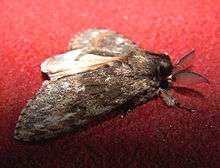Lymantria serva
| Lymantria serva | |
|---|---|
 | |
| Scientific classification | |
| Kingdom: | Animalia |
| Phylum: | Arthropoda |
| Class: | Insecta |
| Order: | Lepidoptera |
| Family: | Lymantriidae |
| Genus: | Lymantria |
| Species: | L. serva |
| Binomial name | |
| Lymantria serva (Fabricius, 1793)[1] | |
| Synonyms | |
| |
Lymantria serva, the Serva tussock moth, Ficus tussock moth, Xian-yue-du-er (Crescent-moon tussock moth) or Hung-do-er (Rainbow tussock moth) (in Chinese) is a moth in the Lymantriidae family. It is found in Nepal, India (Assam) and China (Yunnan). It is possibly also found in Taiwan and Hongkong, but these records might in fact be Lymantria iris.[2]
The length of the forewings is 17–19 mm for males and 26–36 mm for females.
The larvae feed on Ficus species and Shorea robusta. The larvae have an exceptionally long development period with 10 to 12 instars.
References
- ↑ Site Markku Savela
- ↑ Pogue, Michael G. & Paul W. Schaefer (2007) A review of selected species of Lymantria Hübner [1819] (Lepidoptera:Noctuidae:Lymantriinae) from subtropical and temperate regions of Asia, including the description of three new species, some potentially invasive to North America. Washington D.C.: Forest Health Technology Enterprise Team
This article is issued from Wikipedia - version of the Friday, August 15, 2014. The text is available under the Creative Commons Attribution/Share Alike but additional terms may apply for the media files.